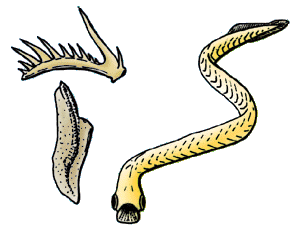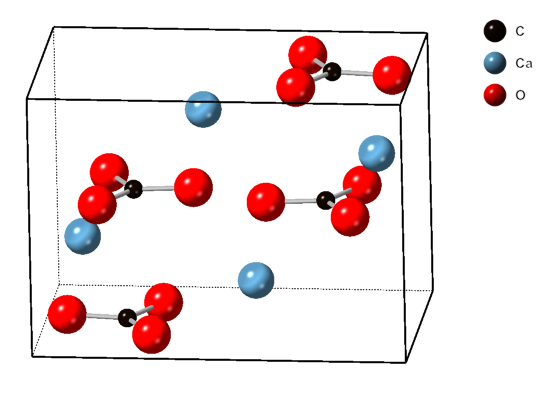|
Belemnitida
Belemnitida (or belemnites) is an extinct order (biology), order of squid-like cephalopods that existed from the Late Triassic to Late Cretaceous (And possibly the Eocene). Unlike squid, belemnites had an internal skeleton that made up the cone. The parts are, from the arms-most to the tip, the tongue-shaped pro-ostracum, the conical phragmocone, and the pointy guard. The calcite, calcitic guard is the most common belemnite remain. Belemnites, in life, are thought to have had 10 hooked arms and a pair of fins on the guard. The chitinous hooks were usually no bigger than , though a belemnite could have had between 100 and 800 hooks in total, using them to stab and hold onto prey. Belemnites were an important food source for many Mesozoic marine creatures, both the adults and the planktonic juveniles and they likely played an important role in restructuring marine ecosystems after the Triassic–Jurassic extinction event. They may have laid between 100 and 1,000 eggs. Some species ... [...More Info...] [...Related Items...] OR: [Wikipedia] [Google] [Baidu] |
Belemnoidea
Belemnoids are an extinct group of marine cephalopod, very similar in many ways to the modern squid. Like them, the belemnoids possessed an ink sac, but, unlike the squid, they possessed ten Cephalopod arm, arms of roughly equal length, and no tentacles. The name "belemnoid" comes from the Greek word βέλεμνον, ''belemnon'' meaning "a dart or arrow" and the Greek word είδος, ''eidos'' meaning "form". Belemnoids include Belemnitida, belemnites (which belong to the Order (biology), order Belemnitida), aulacocerids (order Aulacocerida), phragmoteuthids (order Phragmoteuthida), and diplobelids (order Diplobelida). Belemnoidea has been suggested to be paraphyletic by some authors. Occurrence Belemnoids were numerous during the Jurassic and Cretaceous periods, and their fossils are abundant in Mesozoic marine rocks, often accompanying their cousins the ammonites. The belemnoids become extinct at the end of the Cretaceous period along with the ammonites. The belemnoids' or ... [...More Info...] [...Related Items...] OR: [Wikipedia] [Google] [Baidu] |
Coleoidea
Coleoidea or Dibranchiata is one of the two subclasses of cephalopod molluscs containing all the various taxa popularly thought of as "soft-bodied" or "shell-less" (i.e. octopus, squid and cuttlefish). Unlike its extant sister group Nautiloidea, whose members have a rigid outer shell for protection, the coleoids have at most an internal shell called cuttlebone or gladius that is used for buoyancy or as muscle anchorage. Some species, notably incirrate octopuses, have lost their internal shell altogether, while in some it has been replaced by a chitinous support structure. The major divisions of Coleoidea are based upon the number of arms or tentacles and their structure. The extinct and most primitive form, the Belemnoidea, presumably had ten equally-sized arms in five pairs numbered dorsal to ventral as I, II, III, IV and V. More modern species either modified or lost a pair of arms. The superorder Decapodiformes has arm pair IV modified into long tentacles w ... [...More Info...] [...Related Items...] OR: [Wikipedia] [Google] [Baidu] |
Cephalopod
A cephalopod is any member of the molluscan Taxonomic rank, class Cephalopoda (Greek language, Greek plural , ; "head-feet") such as a squid, octopus, cuttlefish, or nautilus. These exclusively marine animals are characterized by bilateral symmetry, bilateral body symmetry, a prominent head, and a set of cephalopod arm, arms or tentacles (muscular hydrostats) modified from the primitive molluscan foot. Fishers sometimes call cephalopods "inkfish", referring to their common ability to squirt Cephalopod ink, ink. The study of cephalopods is a branch of malacology known as teuthology. Cephalopods became dominant during the Ordovician period, represented by primitive nautiloids. The class now contains two, only distantly related, Extant taxon, extant subclasses: Coleoidea, which includes octopuses, squid, and cuttlefish; and Nautiloidea, represented by ''Nautilus (genus), Nautilus'' and ''Allonautilus''. In the Coleoidea, the molluscan shell has been internalized or is absent, where ... [...More Info...] [...Related Items...] OR: [Wikipedia] [Google] [Baidu] |
Septum (cephalopod)
Septa (singular septum) are thin walls or partitions between the internal chambers (camerae) of the shell of a cephalopod, namely nautiloids or ammonoids. As the creature grows, its body moves forward in the shell to a new living chamber, secreting septa behind it. This adds new chambers to the shell, which can be clearly seen in cross-sections of the shell of the living nautilus, or in ammonoid and nautiloid fossils. The septa are attached to the inside wall of the shell, thus dividing the phragmocone into camerae. Where the septum meets the shell a suture line forms; in some ammonoids these lines became extremely complex and elaborate, providing strength without the necessity of added weight. Elaborate sutures allowed for thinner shells, and hence less time needed for shell growth and less time spent in the vulnerable juvenile stage. The nature and structure of the septa, as with the camerae, and siphuncle, and the presence or absence of deposits, are important in classi ... [...More Info...] [...Related Items...] OR: [Wikipedia] [Google] [Baidu] |
Belemnitina
Belemnitina is a suborder of belemnites, an extinct group of cephalopods. They have been identified as the oldest of all the belemnites and are likely the stockgroup for them. They were extant from the early Jurassic to the early Cretaceous. Their geographic distribution was mostly limited to Europe, although specimens have been described in Japan suggesting they may have been more widespread than previously thought. Morphology They have a broad, rounded pro-ostracum (the section of the guard (the hard internal skeleton commonly fossilised) closest to the head of the living animal). This characteristically lacks longitudinal alveolar canals and the associated splitting surfaces or open fissures. Commonly there are one or more longitudinal furrows in the apical region of the guard, similar furrows may be found in the alveolar region, these would not be accompanied by splitting surfaces or open fissures. Distribution Based on current evidence it appears that the Belemnitina were m ... [...More Info...] [...Related Items...] OR: [Wikipedia] [Google] [Baidu] |
Carnian
The Carnian (less commonly, Karnian) is the lowermost stage (stratigraphy), stage of the Upper Triassic series (stratigraphy), Series (or earliest age (geology), age of the Late Triassic Epoch (reference date), Epoch). It lasted from 237 to 227.3 megaannum, million years ago (Ma). The Carnian is preceded by the Ladinian and is followed by the Norian. Its boundaries are not characterized by major extinctions or biotic turnovers, but a climatic event (known as the Carnian pluvial episode characterized by substantial rainfall) occurred during the Carnian and seems to be associated with important extinctions or biotic radiations. Another extinction occurred at the Carnian-Norian boundary, ending the Carnian age. Stratigraphic definitions The Carnian was named in 1869 by Johann August Georg Edmund Mojsisovics von Mojsvar, Mojsisovics. It is unclear if it was named after the Carnic Alps or after the Austrian region of Carinthia (state), Carinthia (''Kärnten'' in German) or after th ... [...More Info...] [...Related Items...] OR: [Wikipedia] [Google] [Baidu] |
Triassic–Jurassic Extinction Event
The Triassic–Jurassic (Tr-J) extinction event (TJME), often called the end-Triassic extinction, marks the boundary between the Triassic and Jurassic periods, . It represents one of five major extinction events during the Phanerozoic, profoundly affecting life on land and in the oceans. In the seas, about 23–34% of marine genus, genera disappeared; Coral, corals, Bivalvia, bivalves, Brachiopod, brachiopods, Bryozoa, bryozoans, and Radiolaria, radiolarians suffered severe losses of diversity and Conodont, conodonts were completely wiped out, while marine vertebrates, Gastropoda, gastropods, and benthic foraminifera were relatively unaffected. On land, all Archosauromorpha, archosauromorph reptiles other than Crocodylomorpha, crocodylomorphs, dinosaurs, and pterosaurs became extinct. Crocodylomorphs, dinosaurs, pterosaurs, and mammals were left largely untouched, allowing them to become the dominant land animals for the next 135 million years. Plants were likewise significantly a ... [...More Info...] [...Related Items...] OR: [Wikipedia] [Google] [Baidu] |
Gladius (cephalopod)
The gladius (: ''gladii''), or pen, is a hard internal bodypart found in many cephalopods of the superorder Decapodiformes (particularly squids) and in a single extant taxon, extant member of the Octopodiformes, the vampire squid (''Vampyroteuthis infernalis''). It is so named for its superficial resemblance to the Roman Empire, Roman Gladius, short sword of the same name, and is a Vestigiality, vestige of the ancestral mollusc shell, which was external. The gladius is located Dorsal (anatomy), dorsally within the mantle (mollusc), mantle and usually extends for its entire length. Composed primarily of chitin, it lies within the shell sac, which is responsible for its secretion. Some species, like the bigfin reef squid, still has a gladius with some degree of mineralization. Gladii are known from a number of extinct cephalopod groups, including Teudopseina, teudopseids (''e.g.'' ''Actinosepia'', ''Glyphiteuthis'', ''Muensterella'', ''Palaeololigo'', ''Teudopsinia'', ''Teudopsis'', ... [...More Info...] [...Related Items...] OR: [Wikipedia] [Google] [Baidu] |
Aragonite
Aragonite is a carbonate mineral and one of the three most common naturally occurring crystal forms of calcium carbonate (), the others being calcite and vaterite. It is formed by biological and physical processes, including precipitation from marine and freshwater environments. The crystal lattice of aragonite differs from that of calcite, resulting in a different crystal shape, an orthorhombic crystal system with acicular crystal. Repeated twinning results in pseudo-hexagonal forms. Aragonite may be columnar or fibrous, occasionally in branching helictitic forms called ''flos-ferri'' ("flowers of iron") from their association with the ores at the Carinthian iron mines. Occurrence The type location for aragonite is Molina de Aragón in the Province of Guadalajara in Castilla-La Mancha, Spain, for which it was named in 1797. Aragonite is found in this locality as cyclic twins inside gypsum and marls of the Keuper facies of the Triassic. This type of aragoni ... [...More Info...] [...Related Items...] OR: [Wikipedia] [Google] [Baidu] |
Connective Tissue
Connective tissue is one of the four primary types of animal tissue, a group of cells that are similar in structure, along with epithelial tissue, muscle tissue, and nervous tissue. It develops mostly from the mesenchyme, derived from the mesoderm, the middle embryonic germ layer. Connective tissue is found in between other tissues everywhere in the body, including the nervous system. The three meninges, membranes that envelop the brain and spinal cord, are composed of connective tissue. Most types of connective tissue consists of three main components: elastic and collagen fibers, ground substance, and cells. Blood and lymph are classed as specialized fluid connective tissues that do not contain fiber. All are immersed in the body water. The cells of connective tissue include fibroblasts, adipocytes, macrophages, mast cells and leukocytes. The term "connective tissue" (in German, ) was introduced in 1830 by Johannes Peter Müller. The tissue was already recognized as ... [...More Info...] [...Related Items...] OR: [Wikipedia] [Google] [Baidu] |
Octopus
An octopus (: octopuses or octopodes) is a soft-bodied, eight-limbed mollusc of the order Octopoda (, ). The order consists of some 300 species and is grouped within the class Cephalopoda with squids, cuttlefish, and nautiloids. Like other cephalopods, an octopus is bilaterally symmetric with two eyes and a beaked mouth at the centre point of the eight limbs. An octopus can radically deform its shape, enabling it to squeeze through small gaps. They trail their appendages behind them as they swim. The siphon is used for respiration and locomotion (by water jet propulsion). Octopuses have a complex nervous system and excellent sight, and are among the most intelligent and behaviourally diverse invertebrates. Octopuses inhabit various ocean habitats, including coral reefs, pelagic waters, and the seabed; some live in the intertidal zone and others at abyssal depths. Most species grow quickly, mature early, and are short-lived. In most species, the male uses a speciall ... [...More Info...] [...Related Items...] OR: [Wikipedia] [Google] [Baidu] |







